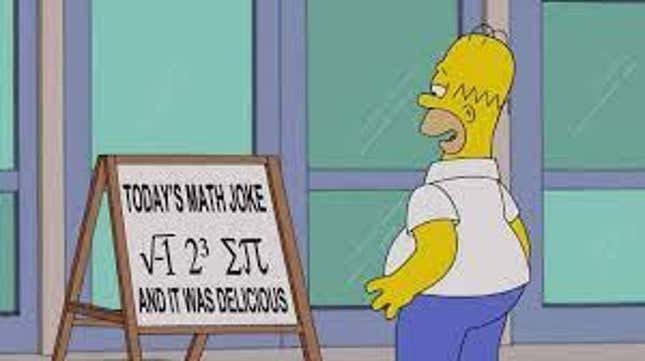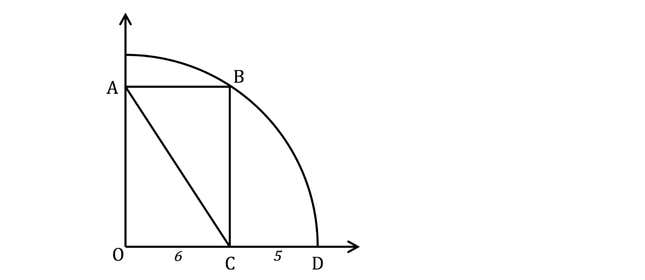Hidden amid its trademark satire of common American life, The Simpsons is riddled with mathematical Easter eggs. The present’s writing employees has boasted a formidable pedigree of Ivy League mathheads who couldn’t resist infusing America’s longest-running sitcom with inside jokes, scattered about like sprinkles on Homer’s doughnuts.
As early because the opening shot of the present’s second episode, the perpetually one-year outdated child, Maggie, stacks her alphabet blocks to learn EMCSQU. Little question an homage to Einstein’s well-known equation E = mc2.
There’s an episode the place Homer tries to turn into an inventor and he engineers a number of harebrained concepts, together with a shotgun that blasts make-up in your face and a recliner with a built-in bathroom. Throughout a brainstorming frenzy, Homer scribbles some equations on a chalkboard together with:
198712 + 436512 = 447212
This references Fermat’s Final Theorem, one of the notorious equations in math historical past. The potted model, in the event you haven’t come throughout it: seventeenth century mathematician Pierre de Fermat wrote that the equation an + bn = cn has no entire quantity options when n is larger than 2. In different phrases, you may’t discover three entire numbers (non-decimal numbers like 1, 2, 3…) a, b, and c such that a3 + b3 = c3 or a4 + b4 = c4, and so forth. Fermat wrote that he had “found a really marvelous proof of this” however couldn’t match it within the margin of his textual content. Later mathematicians discovered this message and, regardless of the easy look of the declare, did not show it. It went unproven for over 4 centuries till Andrew Wiles lastly cracked it in 1994. Wiles’ proof depends on methods way more superior than what was obtainable in Fermat’s day, which leaves open the tantalizing risk that Fermat knew of a extra elementary proof that we now have but to find (or his supposed proof had a bug).
Plug Homer’s equation into your calculator. It checks out! Did The Simpsons discover a counterexample to Fermat’s Final Theorem? It seems that Homer’s trio of numbers represent a near-miss. Most calculators don’t show sufficient precision to detect the slight discrepancy between the 2 sides of the equation. Author David X. Cohen wrote his personal laptop program to seek for near-miss options to Fermat’s infamous equation all for this split-second gag.
This week’s puzzle comes from the season 26 finale, through which the denizens of Springfield take part in a mathlete competitors. The episode is filled with mathematical goodies, together with the little joke under posted exterior of the competitors. Are you able to decipher it?

The climactic tie-breaking geometry downside is harder than it seems. I hope it doesn’t make you shout, “D’oh!”
Did you miss final week’s puzzle? Test it out here, and discover its resolution on the backside of at present’s article. Watch out to not learn too far forward in the event you haven’t solved final week’s but!
Puzzle #20: The Simpsons M
Add three straight traces to the diagram to create 9 non-overlapping triangles.

The triangles might share sides, however shouldn’t share inside house. For instance, the left-hand determine under depicts two triangles, whereas the right-hand determine solely counts as one triangle, as a result of the bigger triangle overlaps with the smaller one.

I’ll submit the reply subsequent Monday together with a brand new puzzle. Have you learnt a cool puzzle that you just suppose must be featured right here? Message me on Twitter @JackPMurtagh or e-mail me at gizmodopuzzle@gmail.com
Resolution to Puzzle #19: Psychological Illusions
How did you fare on final week’s problems? I in contrast them to optical illusions as a result of each puzzles seem at first blush to require some concerned calculation. However when you understand the hidden trick, the answer snaps into focus like Necker cubes abruptly inverting. Each puzzles are literally gimmes, with the fitting perspective. Shout-out to reader McKay, who submitted two right solutions over e-mail.
1. It should take at most one minute for the entire ants to fall off an finish of the meter stick. It appears sophisticated to trace the oscillating habits of every ant. Couldn’t they bobble backwards and forwards endlessly? If you squint your eyes, you’ll see that the situation the place two colliding ants instantly change their instructions isn’t any completely different from the case the place the ants transfer proper by one another! In each instances, there might be ants at precisely the identical factors alongside the stick strolling in the identical route.
Think about every ant was sporting somewhat high hat and at any time when two collide they immediately swap hats earlier than carrying on in the other way. Observe a single high hat’s path and also you’ll discover that it simply beelines for one finish of the stick at a relentless tempo the entire time. Since ants transfer at one meter per minute and the longest any ant may need to journey is the complete size of the meter stick, the entire ants will attain an finish of the stick inside one minute.
2. How concerning the geometry downside?

What’s the size of AC?
It seems SAT-ready. Perhaps the Pythagorean theorem is so as. Maybe a trigonometric identification or two. Blink twice and the phantasm of complexity vanishes. The road connecting factors O and B can be a diagonal of the rectangle and can have the identical size as AC. Solely OB is extra helpful as a result of it’s a radius of the circle! The diagram tells us the circle’s radius alongside the x-axis: 6+5 = 11, our reply.
Trending Merchandise

Cooler Master MasterBox Q300L Micro-ATX Tower with Magnetic Design Dust Filter, Transparent Acrylic Side Panel, Adjustable I/O & Fully Ventilated Airflow, Black (MCB-Q300L-KANN-S00)

ASUS TUF Gaming GT301 ZAKU II Edition ATX mid-Tower Compact case with Tempered Glass Side Panel, Honeycomb Front Panel, 120mm Aura Addressable RGB Fan, Headphone Hanger,360mm Radiator, Gundam Edition

ASUS TUF Gaming GT501 Mid-Tower Computer Case for up to EATX Motherboards with USB 3.0 Front Panel Cases GT501/GRY/WITH Handle

be quiet! Pure Base 500DX Black, Mid Tower ATX case, ARGB, 3 pre-installed Pure Wings 2, BGW37, tempered glass window

ASUS ROG Strix Helios GX601 White Edition RGB Mid-Tower Computer Case for ATX/EATX Motherboards with tempered glass, aluminum frame, GPU braces, 420mm radiator support and Aura Sync










